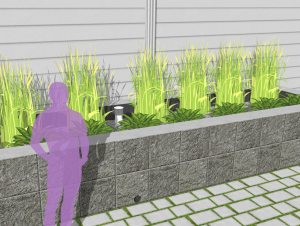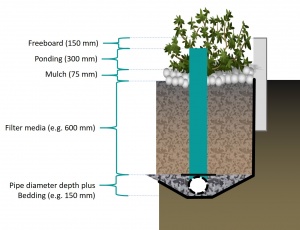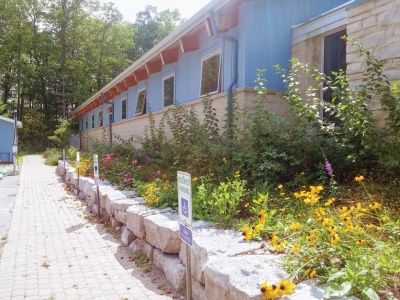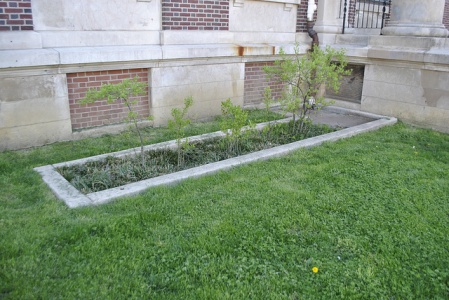Difference between revisions of "Stormwater planters"
| (40 intermediate revisions by 6 users not shown) | |||
| Line 1: | Line 1: | ||
<imagemap> | <imagemap> | ||
File:Bioretention No infiltration placementswap final.png|thumb|600 px|Stormwater planter or no infiltration bioretention cell draining a parking lot. This design variation includes an impermeable liner, an underdrain and surface overflow pipes to allow excess water to leave the practice. <span style="color:red">''A note: The following is an "image map", feel free to explore the image with your cursor and click on highlighted labels that appear to take you to corresponding pages on the Wiki.''</span> | |||
rect | rect 1288 1419 1353 1483 [[Underdrains|Underdrain Access Structure]] | ||
rect 1290 2822 1345 3140 [[Underdrains|Underdrain Access Structure]] | |||
rect | rect 1288 3142 1345 3191 [[Underdrains|Underdrain]] | ||
rect | poly 866 326 866 241 1386 241 1386 416 1392 683 1337 620 1270 579 1278 410 1241 339 1078 326 1045 398 1049 400 992 355 [[Mulch|Mulch]] | ||
poly 870 685 868 610 1000 567 1004 632 [[Mulch|Mulch]] | |||
rect | poly 868 1028 966 1081 1021 1370 864 1485 870 1283 868 1211 870 1136 [[Mulch|Mulch]] | ||
poly 990 1397 1045 1482 1110 1485 1111 1421 [[Mulch|Mulch]] | |||
rect | poly 1214 1389 1263 1419 1339 1440 1390 1446 1384 1491 1161 1497 [[Mulch|Mulch]] | ||
rect | poly 1292 1062 1386 1032 1384 1164 1249 1209 [[Mulch|Mulch]] | ||
rect | rect 1027 379 870 575 [[Stone|Erosion Control - Stone]] | ||
rect | rect 1241 1223 1392 1432 [[Stone|Erosion Control - Stone]] | ||
rect | rect 815 389 868 540 [[Curb cuts|Curb Cut]] | ||
rect 1398 1234 1441 1378 [[Curb cuts|Curb Cut]] | |||
rect | rect 862 685 1388 1038 [[Trees: List|Tree]] | ||
rect | rect 1068 351 1245 648 [[Plant lists|Vegetation]] | ||
rect | rect 1007 1089 1235 1399 [[Plant lists|Vegetation]] | ||
rect 939 1415 1011 1482 [[Overflow|Overflow Outlet]] | |||
rect 854 1652 1408 2651 [[Trees: List|Tree]] | |||
rect 1064 2684 1227 2822 [[Plant lists|Vegetation]] | |||
rect 862 2863 955 2940 [[Flow through media|Ponding Depth]] | |||
rect 1017 2902 1119 2942 [[Mulch|Mulch]] | |||
rect 1164 2900 1398 2938 [[Mulch|Mulch]] | |||
rect 960 3126 1019 3175 [[Overflow|Overflow Outlet Pipe]] | |||
rect 956 2845 1017 3177 [[Overflow|Overflow Outlet]] | |||
rect 864 2943 955 3079 [[Bioretention: Filter media|Filter Media]] | |||
rect 1023 2941 1111 3083 [[Bioretention: Filter media|Filter Media]] | |||
rect 1168 2938 1392 3081 [[Bioretention: Filter media|Filter Media]] | |||
rect 866 3083 953 3116 [[Choker layer|Choker Layer]] | |||
rect 1021 3079 1110 3116 [[Choker layer|Choker Layer]] | |||
rect 1168 3085 1386 3116 [[Choker layer|Choker Layer]] | |||
rect 868 3120 955 3185 [[Reservoir aggregate|Clear Stone / Aggregate]] | |||
rect 1023 3114 1113 3189 [[Reservoir aggregate|Clear Stone / Aggregate]] | |||
rect 1170 3116 1388 3191 [[Reservoir aggregate|Clear Stone / Aggregate]] | |||
rect 825 3238 1439 3279 [[Soil groups|Compacted Subgrade Soil]] | |||
rect 825 2867 862 3238 [[Liner|Impermeable Liner]] | |||
rect 862 3191 1437 3242 [[Liner|Impermeable Liner]] | |||
rect 1392 2865 1439 3193 [[Liner|Impermeable Liner]] | |||
</imagemap> | </imagemap> | ||
[[File:Stormwater planter pu.png|thumb|An above ground planter with downspout and overflow illustrated.]] | |||
Over | [[File:Stormwater planter pu.png|thumb|An above ground stormwater planter with downspout and overflow illustrated.]] | ||
Over underground infrastructure, soils prone to subsidence, or on sites considered to be pollution hot spots, it may be necessary to prevent all [[infiltration]]. Stormwater planters are "no infiltration" or "filtration-only" BMPs, similar to bioretention cells, that can be squeezed into tight urban spaces, adjacent to buildings and within the usual setbacks required for infiltrating facilities. Stormwater planters can also be used as a means of providing building-integrated LID by capturing a portion of the rainwater from the rooftop. | |||
This type of cell can be constructed above grade in any waterproof and structurally sound container, e.g. in cast concrete or a metal tank. | This type of cell can be constructed above grade in any waterproof and structurally sound container, e.g. in cast concrete or a metal tank. | ||
{{TOClimit|2}} | {{TOClimit|2}} | ||
| Line 28: | Line 49: | ||
*Sites which cannot infiltrate water owing to contaminated soils or shallow bedrock, | *Sites which cannot infiltrate water owing to contaminated soils or shallow bedrock, | ||
*Zero-lot-line developments such as condos or dense urban infill.}} | *Zero-lot-line developments such as condos or dense urban infill.}} | ||
Take a look at the downloadable Bioretention Factsheet below for a .pdf overview of this LID Best Management Practice: | |||
{{Clickable button|[[File:Bioretention.png|125 px|link=https://wiki.sustainabletechnologies.ca/images/5/5a/LID_poster_-_bioretention_-_vfinal2.pdf]]}} | |||
'''The fundamental components of a stormwater planter are:''' | '''The fundamental components of a stormwater planter are:''' | ||
*a planting bed of [[ | *a planting bed of [[Filter media| filter media]], | ||
*suitable vegetation, | *suitable [[Plant lists| vegetation]], | ||
*decorative aggregate or [[stone]], | *decorative aggregate or [[stone]], | ||
*An [[underdrain]] | *An [[underdrain]], | ||
*An impermeable [[liner]] | |||
'''The design may benefit from:''' | '''The design may benefit from:''' | ||
*A [[level spreaders| level spreader]] | *A [[level spreaders| level spreader]] | ||
==Planning Considerations== | ==Planning Considerations== | ||
Stormwater | Stormwater planters may be integrated into the landscape similarly to bioretention practices. See [[Bioretention#Planning considerations|bioretention planning]]. | ||
===Additional site opportunities=== | |||
As they do not require connection to the earth for infiltration purposes, stormwater planters can also be used in elevated locations. They are sometimes used in retrofit applications on otherwise impermeable surface, as raised beds or planters surrounding buildings. They can be employed to capture runoff from [[downspout disconnection| roof drains or downspouts]] or even upon terraces or vertical surfaces of buildings. | |||
==Design== | ==Design== | ||
{{:Planters: Sizing}} | {{:Planters: Sizing}} | ||
=== | ===Filter media=== | ||
[[ | See [[Bioretention: Filter media]] | ||
===Underdrain=== | ===Underdrain=== | ||
Stormwater planters differ | Stormwater planters differ from full and/or partial infiltration [[bioretention]] practices in that the storage function is provided only by the [[water retention capacity]] of the [[filter media]]. As such, there is no storage reservoir and the only purpose to the aggregate layer is to drain water to the perforated [[pipe]]. For this, a medium aggregate as described in [[choker layer]] is recommended as it negates the need for a separating layer to the filter media. Design details can be found here [[Underdrains#Underdrains for non-exfiltrating practices|Underdrains]] for non-exfiltrationg practices. | ||
[[Underdrains#Underdrains for non-exfiltrating practices| | |||
===Planting=== | ===Planting=== | ||
| Line 55: | Line 92: | ||
*The [[plant lists]] are still a good place to start when selecting species for LID in Ontario. | *The [[plant lists]] are still a good place to start when selecting species for LID in Ontario. | ||
*A more formal aesthetic for the planting design is appropriate for the urban hardscape setting. | *A more formal aesthetic for the planting design is appropriate for the urban hardscape setting. | ||
<imagemap> | |||
file:Stormwater Planter Updated compacted.png|thumb|450 px|Stormwater planter with impermeable membrane liner receiving roof and sidewalk runoff via trench drain. <span style="color:red">''A note: The following is an "image map", feel free to explore the image with your cursor and click on highlighted labels that appear to take you to corresponding pages on the Wiki.''</span> | |||
rect 718 2598 767 3057 [[Underdrains|Underdrain Access Structure]] | |||
rect 1931 1137 2000 1216 [[Downspout disconnection|Roof Downspout]] | |||
rect 1940 1796 2000 2703 [[Downspout disconnection|Roof Downspout]] | |||
rect 293 1040 413 1322 [[Inlets]] | |||
rect 1065 1055 1174 1324 [[Inlets]] | |||
rect 217 1095 286 1289 [[Curb cut]] | |||
rect 293 2736 467 2796 [[Inlets]] | |||
rect 979 2740 1155 2794 [[Inlets]] | |||
rect 1130 2678 1255 2734 [[Inlets]] | |||
rect 288 1342 1168 1521 [[Graminoids:_List| Grasses]] | |||
rect 291 314 477 1028 [[Graminoids:_List| Grasses]] | |||
rect 489 309 1183 519 [[Graminoids:_List| Grasses]] | |||
rect 1050 530 1179 1020 [[Graminoids:_List| Grasses]] | |||
rect 700 1267 782 1351 [[Underdrains|Underdrain Access Structure]] | |||
rect 705 411 1013 1092 [[Shrubs: List|Shrubs]] | |||
rect 753 2109 1028 2562 [[Shrubs: List|Shrubs]] | |||
rect 465 363 694 1149 [[Perennials: List| Perennials]] | |||
rect 450 408 373 339 [[Overflow]] | |||
rect 467 2740 985 2798 [[Mulch]] | |||
rect 1053 870 1161 1146 [[Forebays]] | |||
rect 705 3059 774 3126 [[Underdrain]] | |||
rect 699 2416 752 2883 [[Overflow]] | |||
rect 266 2329 448 2566 [[Graminoids:_List| Grasses]] | |||
rect 400 2183 703 2566 [[Perennials: List| Perennials]] | |||
rect 1035 2376 1104 2571 [[Graminoids:_List| Grasses]] | |||
rect 291 2798 1155 3059 [[Biomedia|Filter Media]] | |||
poly 344 3056 742 3130 1101 3057 [[Choker layer|Choker Layer]] | |||
poly 290 2740 270 2736 275 3065 745 3154 1177 3068 1174 2741 1155 2740 1155 3050 740 3130 290 3046 [[Liner]] | |||
rect 99 3052 184 3141 [[Overflow|Outlet Distribution Pipe to Storm Sewer]] | |||
rect 77 2652 204 3217 [[Overflow|Catch basin]] | |||
rect 1252 1140 1929 1218 [[Trench drains: Gallery|Trench drains]] | |||
rect 1248 2647 1916 2738 [[Trench drains: Gallery|Trench drains]] | |||
poly 738 3152 1175 3068 1172 3217 273 3215 273 3061 [[Soil groups|Compacted Subgrade Soil]] | |||
rect 469 2652 714 2798 [[Flow through media|Ponding Depth]] | |||
rect 79 859 222 982 [[Overflow|Catch basin]] | |||
</imagemap> | |||
Over underground infrastructure, soils prone to subsidence, or on sites considered to be pollution hot spots, it may be necessary to prevent all [[infiltration]]. Stormwater planters are "filtration-only" BMPs, similar to bioretention cells, that can be squeezed into tight urban spaces, adjacent to buildings and within the usual setbacks required for infiltrating facilities. Stormwater planters can also be used as a means of providing building-integrated LID by capturing a portion of the rainwater from the rooftop. | |||
This type of cell can be constructed above grade in any waterproof and structurally sound container, e.g. in cast concrete or a metal tank. | |||
===Liners=== | ===Liners=== | ||
{{:Liner}} | {{:Liner}} | ||
== | ==Filter bed surface== | ||
As stormwater planters are often quite small and receive very rapid flow, both a [[level spreader]] and the use of | As stormwater planters are often quite small and receive very rapid flow, both a [[level spreader]] and the use of mulch and stone to dissipate energy from concentrated inflow are strongly recommended. | ||
==Gallery== | ==Gallery== | ||
| Line 66: | Line 148: | ||
==Performance== | ==Performance== | ||
===Hydrology=== | ===Hydrology=== | ||
Latest revision as of 20:56, 8 March 2022
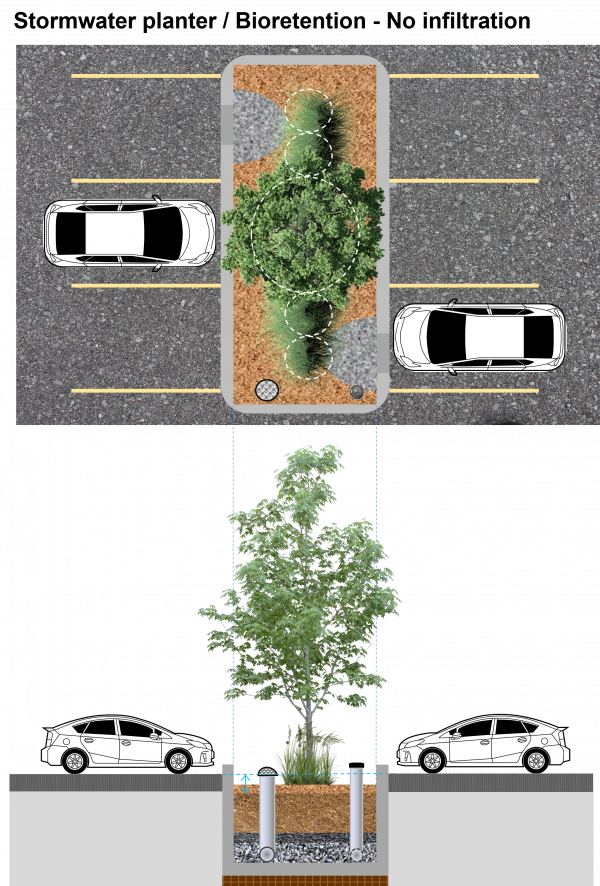
Over underground infrastructure, soils prone to subsidence, or on sites considered to be pollution hot spots, it may be necessary to prevent all infiltration. Stormwater planters are "no infiltration" or "filtration-only" BMPs, similar to bioretention cells, that can be squeezed into tight urban spaces, adjacent to buildings and within the usual setbacks required for infiltrating facilities. Stormwater planters can also be used as a means of providing building-integrated LID by capturing a portion of the rainwater from the rooftop. This type of cell can be constructed above grade in any waterproof and structurally sound container, e.g. in cast concrete or a metal tank.
Overview[edit]
Stormwater planters are an ideal technology for:
- Sites which cannot infiltrate water owing to contaminated soils or shallow bedrock,
- Zero-lot-line developments such as condos or dense urban infill.
Take a look at the downloadable Bioretention Factsheet below for a .pdf overview of this LID Best Management Practice:
The fundamental components of a stormwater planter are:
- a planting bed of filter media,
- suitable vegetation,
- decorative aggregate or stone,
- An underdrain,
- An impermeable liner
The design may benefit from:
Planning Considerations[edit]
Stormwater planters may be integrated into the landscape similarly to bioretention practices. See bioretention planning.
Additional site opportunities[edit]
As they do not require connection to the earth for infiltration purposes, stormwater planters can also be used in elevated locations. They are sometimes used in retrofit applications on otherwise impermeable surface, as raised beds or planters surrounding buildings. They can be employed to capture runoff from roof drains or downspouts or even upon terraces or vertical surfaces of buildings.
Design[edit]
This article is specific to flow-through stormwater planters, vegetated systems that do not infiltrate water to the native soil.
If you are designing a planted system which does infiltrate water, see advice on Bioretention: Sizing.
The dimensions of a stormwater planter are largely predetermined according to the function of the component. As they do not contain a storage reservoir the planters rely more upon careful selection of materials. Both the filter media and the perforations of the pipe play critical roles for flow control.
| Component | Recommended depth (with underdrain pipe) | Typical porosity (n) |
|---|---|---|
| Ponding (dp) | 150 to 450 mm | 1 |
| Mulch | 75 ± 25 mm |
|
| Filter media (dm) |
|
|
| Pipe diameter reservoir | Is equal to underdrain pipe diameter | 0.4 |
| Pipe bedding (db) | 50 mm (although commonly omitted altogether). | 0.4 |
Filter media[edit]
See Bioretention: Filter media
Underdrain[edit]
Stormwater planters differ from full and/or partial infiltration bioretention practices in that the storage function is provided only by the water retention capacity of the filter media. As such, there is no storage reservoir and the only purpose to the aggregate layer is to drain water to the perforated pipe. For this, a medium aggregate as described in choker layer is recommended as it negates the need for a separating layer to the filter media. Design details can be found here Underdrains for non-exfiltrationg practices.
Planting[edit]
- Planters must be designed in a way that insulates the soil through freezing temperatures, or plant species that can survive the winter season in raised planters must be used.
- Stormwater planters routinely capture only rainwater flowing from adjacent rooftops. This means that salt may be less of a concern than in Bioretention: Parking lots or Bioretention: Streetscapes.
- The plant lists are still a good place to start when selecting species for LID in Ontario.
- A more formal aesthetic for the planting design is appropriate for the urban hardscape setting.
Error: Image is invalid or non-existent.
Over underground infrastructure, soils prone to subsidence, or on sites considered to be pollution hot spots, it may be necessary to prevent all infiltration. Stormwater planters are "filtration-only" BMPs, similar to bioretention cells, that can be squeezed into tight urban spaces, adjacent to buildings and within the usual setbacks required for infiltrating facilities. Stormwater planters can also be used as a means of providing building-integrated LID by capturing a portion of the rainwater from the rooftop.
This type of cell can be constructed above grade in any waterproof and structurally sound container, e.g. in cast concrete or a metal tank.
Liners[edit]
An impermeable liner is incorporated into non-infiltrating practices such as stormwater planters, and may be applied in permeable pavements installations where separation from the native soils and groundwater is required.
- Waterproof containment can be created using concrete or a plastic membrane/liner (HDPE or EPDM are common materials).
- When the membrane is being used directly in the ground, punctures from stones can be prevented by compacting a layer sand (30 - 50 mm) over the soil prior to installing the membrane.
- Alternatively, a manufactured cushion fabric (geotextile) can be employed for this purpose.
- The top surface of the membrane must also be protected from stone and gravel being used for inside the BMP. Again, sand or a cushion fabric may be used.
- When a pipe is used to provide drainage from the practice to an outlet structure or storm sewer, a 'pipe boot' or flange should be sealed to both the pipe and the liner to prevent leaks.
Filter bed surface[edit]
As stormwater planters are often quite small and receive very rapid flow, both a level spreader and the use of mulch and stone to dissipate energy from concentrated inflow are strongly recommended.
Gallery[edit]
Stormwater planters are ideal for situating alongside buildings to capture rainwater from roof runoff. LSRCA headquarters, 2017.
Stormwater planter, treating downspout runoff, at Waterview Rec Center, Philidelphia
Photo credit: PWDRain garden, Illick Hall, SUNY College of Environmental Science and Forestry, Syracuse, NY
Photo credit: DASonnenfeld
Performance[edit]
Hydrology[edit]
Water quality[edit]
See Also[edit]
Proprietary links[edit]
A number of precast modules exist to contain treatment media. As many of these systems are enclosed water balance calculations may be erroneous where evapotranspiration is constrained.
In our effort to make this guide as functional as possible, we have decided to include proprietary systems and links to manufacturers websites.
Inclusion of such links does not constitute endorsement by the Sustainable Technologies Evaluation Program.
Lists are ordered alphabetically; link updates are welcomed using the form below.
- ↑ Davis, Allen P., Robert G. Traver, William F. Hunt, Ryan Lee, Robert A. Brown, and Jennifer M. Olszewski. “Hydrologic Performance of Bioretention Storm-Water Control Measures.” Journal of Hydrologic Engineering 17, no. 5 (May 2012): 604–14. doi:10.1061/(ASCE)HE.1943-5584.0000467.
- ↑ Yeakley, J.A., and K.K. Norton. “Performance Assessment of Three Types of Rainwater Detention Structures for an Urban Development in Wilsonville, Oregon, USA,” 70. Portland, 2009.
- ↑ Macnamara, J.; Derry, C. Pollution Removal Performance of Laboratory Simulations of Sydney’s Street Stormwater Biofilters. Water 2017, 9, 907.;doi:10.3390/w9110907
- ↑ Lucke, T., & Nichols, P. W. B. (2015). The pollution removal and stormwater reduction performance of street-side bioretention basins after ten years in operation. Science of The Total Environment, 536, 784–792. https://doi.org/10.1016/J.SCITOTENV.2015.07.142
- ↑ Macnamara, J.; Derry, C. Pollution Removal Performance of Laboratory Simulations of Sydney’s Street Stormwater Biofilters. Water 2017, 9, 907. doi:10.3390/w9110907
